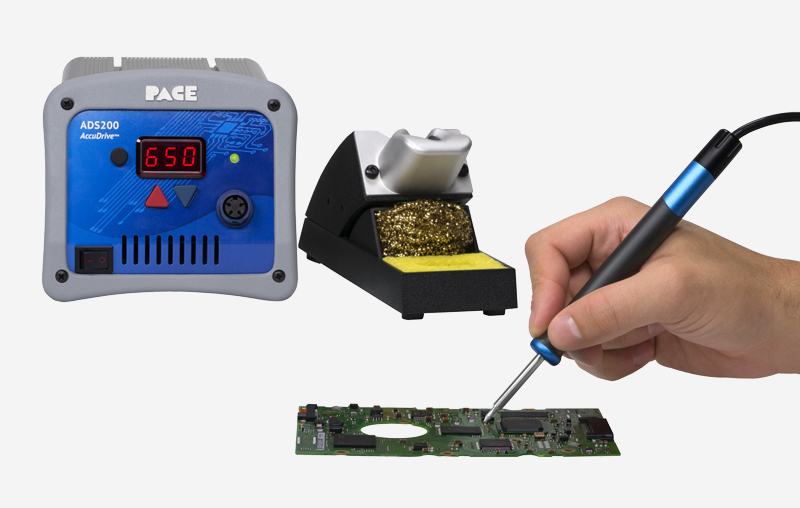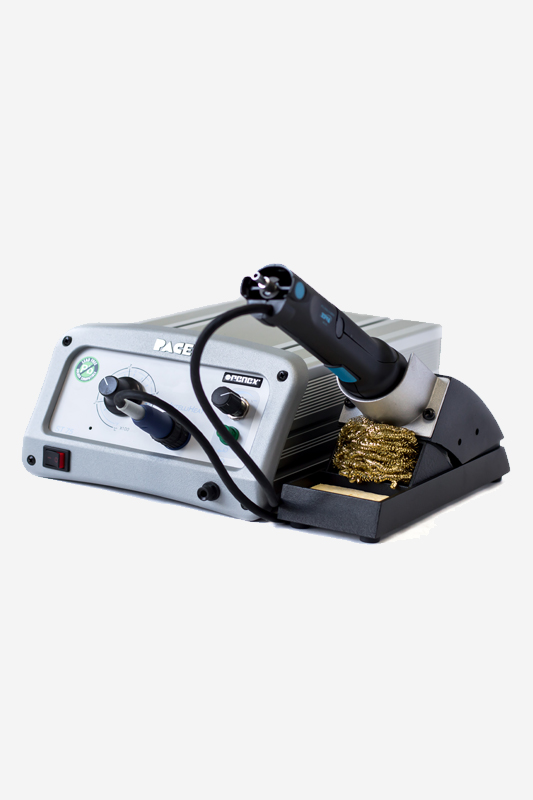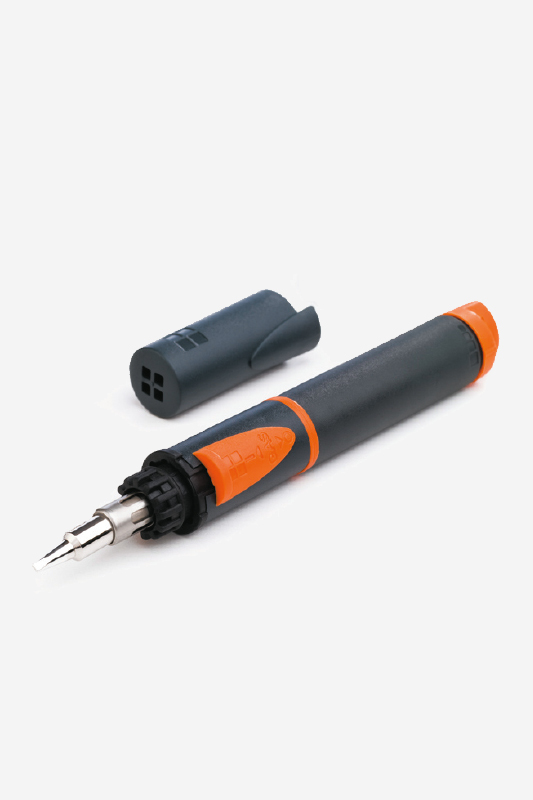A device made of the best components will not work properly and faultlessly if the quality of connections is not properly maintained during production. In electronic equipment the key role is played by soldered connections. Due to the high degree of miniaturization of components, the technical requirements for the soldering process are currently particularly stringent.
The family of PACE soldering stations of the ST line presented a month ago has recently been supplemented with two new stations: HW100 and TW100. Their world premiere took place at the international SMT fair, which took place in Nuremberg in June this year. They are distinguished by their original, attractive design, but above all they offer greater possibilities, mainly in terms of efficiency and ergonomics, achieved by using a tip of a new design. The heater and soldering tip have been integrated in a single, interchangeable part of the handle, which has made it possible to reduce the distance between them and significantly improve heat transfer. As a result, it is possible to change the energy supplied to the soldering point very quickly: the temperature of the soldering tip adapts almost instantaneously to current needs, depending on the ambient temperature, the surface of the soldering point, the type and volume of solder, among other things.
The soldering process can therefore take place at a lower, safer temperature, and yet in a shorter time. The tips can be replaced without switching off the power. Their construction ensures reliable positioning and stable fixing in the body. High-quality electrical connections are guaranteed by gold-plated contacts and a sealing ring, protecting them from the harmful effects of aggressive fumes. The soldering handle has been designed taking into account the requirements of ergonomics – engineers specializing in designing surgical instruments took part in the works. Both stations are microprocessor controlled.
The differences include, among other things, the way operating temperatures are set and the programming possibilities. The operating parameters of the HW100 are selected by placing a suitable Power Module with mini-jack size in the socket on the front panel. A colour code allows easy identification of the modules. In the TW100, you can enter the desired operating temperature, limit values for the permitted operating range, program the transition to standby and automatically switch off.
The settings made can be password-protected. The built-in self-calibrator guarantees increased accuracy and repeatability of the parameters for the different operating tips. The manufacturer emphasises that the technical advantages of the new soldering stations are reflected in power savings, tip durability and the speed and quality of operators’ work.
FASTER AND MORE ACCURATELY
As the complexity of activities carried out at the production or service station increases, as well as the desire to reduce the time spent on carrying out a sequence of operations, it becomes essential to increase the versatility of the equipment so that the disassembly and assembly of elements does not require additional activities related to the replacement of handles (e.g. suction to soldering). This means that the soldering station should be able to power and control more handles and auxiliary tools. The PACE offer includes MBT201 (two-channel), MBT250/MBT220 (three-channel) and PRC2000 (multi-channel – photo 2) stations. The latter enables independent power supply, programming and control of thermal parameters of three handles. Equipped with three pressure-controlled compressors, it allows e.g. for the simultaneous connection of a tool set for the assembly of SMD systems by means of hot air blowing (reflow soldering, i.e. by means of a handle with a blowing nozzle), a soldering paste dispenser and a pneumatic tweezer, making it easier to move the element and position it on the board. Increasing the assembly speed, especially of SMD systems and BGA components, should not make the quality of the soldering process dependent on the efficiency of the operator. In industrial conditions, after a few hours of operation, the operator’s concentration of attention may decrease, the accuracy of operation may deteriorate and productivity may decrease.
The PLCC and PQFP circuit boards take up relatively large space in relation to the raster, which creates problems with accurate positioning and also makes it difficult to ensure that the thermal process runs properly at each soldering point. In the case of BGA elements, the situation is aggravated by the fact that their leads are placed under the housing: direct visual control of the heating and melting process is impossible. However, hot air must be blown under the element so that the desired temperature is reached at each point (within a given time interval), without moving the element, exceeding the permissible stresses in the board and housing materials and finally without overheating.
Therefore, high precision is needed, both in the spatial arrangement of the element and in relation to the thermal process. Accurate positioning involves the use of a tripod and a system to control the position of the element on the board, as well as to control the position of the working tip (head) in relation to the system being mounted. The soldering itself should be automatic and take into account the characteristics of the specific component. The four phases distinguished in this process: heating, proper heating and cooling differ in duration, range of temperature changes and amount of blown air. These parameters must be properly selected and entered into the device’s memory, as a so-called profile. The described requirements are met by ThermoFlo PACE systems: TF200, consisting of a power supply and control unit and a handle, allowing the use of one of 72 heads for assembly or disassembly. Quick exchange of hot heads during operation is a typical possibility in PACE stations. TF700, complemented by a pre-heating kit for pre-assembly and a stand with a board holder up to 46x51cm. TF2000 (photo 3), the most advanced, computer-controlled system providing, among other things, positioning with an accuracy of 25 µm, as well as depicting the process in the form of a graph on the monitor screen.
BACKGROUND
Although the efficiency and quality of the assembly of electronic systems is determined mainly by the parameters of the stations or soldering systems used and the qualifications of the operators who operate them, it must not be forgotten that an important role is also played by: the type and quality of the solder and fluxes, the method of positioning control, the organization of the workstation and its ergonomics (lighting, correct position of the operator, thermal comfort), the quality of auxiliary tools (such as tweezers, pliers, cutters, tin wire feeders), cleaning products and tools. Regardless of the efficiency requirements, the workstation should be protected against static electricity. Appropriate protective accessories (shoes, clothing, wrist straps) must also be used by the staff.
It is also important to ensure that workers are protected from the harmful effects of substances contained in the fumes and vapours produced during soldering.
This is provided by extraction and filtration equipment. PACE offers a wide range of ARMEVAC extraction systems, serving from one to sixteen stations. These are both relatively simple and lightweight devices (portability) as well as complex and technically advanced (microprocessor control with continuous monitoring of parameters). A large number of available extension arms and heads allows to achieve maximum efficiency of operation on any set-up and spatially configured position. The devices and systems described so far are characterized by versatility (they can be used for assembly and disassembly) and flexibility (quick change-over) of operation.
They can be used in small and large workshops, research and development centres or production plants. However, when the required capacity reaches the level of several thousand assembled elements per hour, it is necessary to use assembly technology in which all stations for preparation of elements and boards, arrangement of elements on boards and for soldering itself are specialized, numerically controlled automatic machines.
OFF GRID
When planning an undertaking related to the production or servicing of electronic devices, the use of electricity is usually taken for granted and the lack of electricity is treated as a serious failure. However, there are situations when it is known in advance that it will be necessary to operate without the ability to power instruments and tools from the power grid. In the case of soldering, a good solution to this particular problem is to use a gas soldering iron, which ensures that sufficient power is obtained for a sufficiently long time. Low weight and lack of power cord allow for comfortable use in difficult spatial conditions (poor access to elements, forced, uncomfortable working position).
An example of such an instrument is the soldering iron Super-Pro (photo 4) by Portasol, designed for standard and precise work. Eleven working tips (of various shapes and dimensions, hot air nozzle, hot knife, cover for shrinking shrink sleeves) enable soldering and processing of cable and wire insulation. Super-Pro can also be used as a burner. Its maximum power is 125W. The temperature is adjustable – reaching 580°C for the tip and 650°C for the blowing air.
The tip reaches a temperature of 350°C in 20 seconds. The gas cylinder (gas for lighters is used here) is in the handle. It can be refilled many times – its capacity provides 2 hours of operation on average. The complete soldering iron is 23 cm long and weighs only 165g. Portasol Hobby Soldering iron is also available with more modest capabilities, but invaluable as a “field” service tool, e.g. for aircraft modelers or RC boat builders. The range of the market offer in the field of devices for mounting electronic circuits is adjusted to the needs and requirements of various users and allows for an optimal selection of equipment for each specific workstation.


